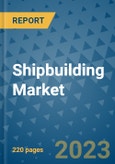The global shipbuilding market is anticipated to offer significant economic opportunities in the coming years, driven by the crucial dependence on waterways and seaports for global trade. With over 80% of trade relying on water transportation, ships play a vital role in the smooth movement of goods across the world. Maritime transport serves as the backbone of global supply chains, international trade, and overall globalization and industrialization. The increasing demand for essential resources like crude oil, steel, and ores in developing economies further fuels the growth of the shipbuilding market. Additionally, as the global population and disposable incomes rise, the consumer base for various products expands, contributing to the exponential growth of the global shipbuilding market.
Rising International Supply through Sea Routes Drives Business Opportunities
Cargo ships have a significant impact on global economic activities. During the forecast period, trade activities through sea routes are projected to remain high, becoming a leading driver of growth in the global shipbuilding market. Seaborne trade generates diverse demand for ships, including tankers, cargo ships, and bulk carriers. Developing economies are increasing their investments in marine trade to strengthen their export and import capabilities. Environmental concerns have historically scrutinized seaborne trade, prompting market players to actively develop sustainable and environmentally friendly ships. These market trends are expected to create favorable business outcomes for the global shipbuilding market.Thriving Global Trade Sustains Promising Growth Trajectory
The global shipping business consists of two major sectors: shipbuilding and maritime transportation. Although distinct, these sectors are highly interdependent. Depression in one sector can significantly impact the other. With flourishing global trade, the transportation segment is set to drive tremendous progress for the global shipbuilding market during the forecast period. Rapid globalization and foreign direct investment activities across economies also contribute to market growth. The booming e-commerce industry is fueling cargo activities worldwide. These factors collectively propel the global shipbuilding market towards maturity.Asia Pacific Leads Global Shipbuilding Market Amidst Manufacturing Activities
Robust manufacturing activities in economies such as China, Japan, and South Korea position Asia Pacific as a leader in the shipbuilding market. The region's thriving import and export activities further strengthen its global leadership. Southeast Asia, including India, Bangladesh, and Pakistan, plays a significant role in ship scrapping activities, accounting for over 90% of global ship scrapping. The flourishing e-commerce industry in the region heavily relies on sea routes in its supply chain, contributing to Asia Pacific's fruitful shipbuilding market.Major Market Entities
The global shipbuilding market is driven by competitive players such as Fincantieri Group, Hyundai Heavy Industries Co., Ltd., Mitsubishi Heavy Industries, Ltd., General Dynamics Corporation, Bae Systems Plc, Sumitomo Heavy Industries, Ltd., Korea Shipbuilding & Offshore Engineering Co., Ltd., Huntington Ingalls Industries, Inc., Oshima Shipbuilding Co., Ltd., Samsung Heavy Industries Co., Ltd, and Damen Shipyards Group.Table of Contents
1. Executive Summary
2. Market Overview
3. Price Trends Analysis
4. Global Shipbuilding Market Outlook, 2018 - 2030
5. North America Shipbuilding Market Outlook, 2018 - 2030
6. Europe Shipbuilding Market Outlook, 2018 - 2030
7. Asia Pacific Shipbuilding Market Outlook, 2018 - 2030
8. Latin America Shipbuilding Market Outlook, 2018 - 2030
9. Middle East & Africa Shipbuilding Market Outlook, 2018 - 2030
10. Competitive Landscape
11. Appendix
Companies Mentioned
- Hyundai Heavy Industries
- China Shipbuilding Group (CSG)
- Daewoo Shipbuilding & Marine Engineering (DSME)
- Samsung Heavy Industries
- K Shipbuilding Co., Ltd.
- Fincantieri S.p.A.
- Chantiers de l’Atlantique (Formerly STX France)
- JSC United S
Methodology

LOADING...








